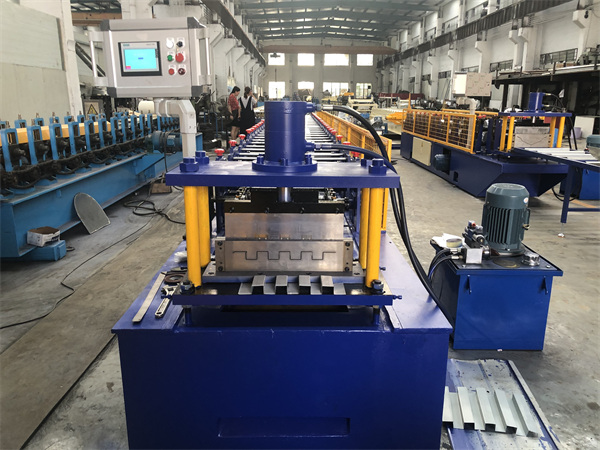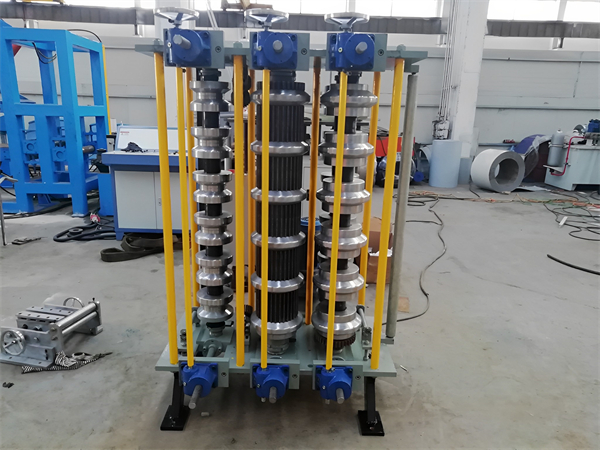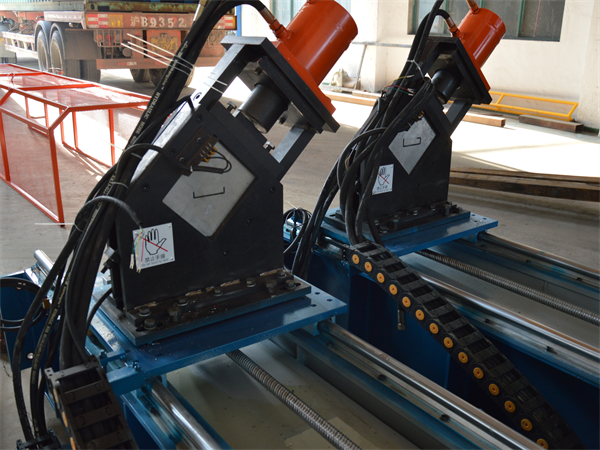Pipe roll forming machines are an efficient and cost-effective way to manufacture pipes and tubes from sheet or coil metal. This comprehensive guide covers everything you need to know about pipe roll forming machine types, components, specifications, applications, operation, maintenance and more.
Overview of Pipe Roll Forming Machines
Roll forming is a continuous bending process that forms sheet metal into cylindrical or tubular cross-sections by progressively bending the workpiece through a series of roll stations. Pipe roll forming machines consist of a decoiler, pre-roller straightener, roller dies, post-forming stations and a cutoff press assembled in a continuous production line.
The sheet or coil is fed through the rolling dies at each station to incrementally bend the material into the desired tubular shape. Each roller die makes a small bend until the full profile is formed. Rollers can form a variety of round, rectangular or shaped metal tubes.
Key benefits of pipe roll forming include:
- High production speeds up to 100 ft/min
- Consistent quality and precision with roller die forming
- Flexibility to form different sizes and material gauges
- Cost efficiency for long production runs
Pipe roll forming is ideal for producing cylindrical tubes, pipes, hollow sections, panels and enclosures in medium to high volumes from metals like steel, aluminum and copper.
Table 1. Overview of Pipe Roll Forming Machines
| Parameters | Details |
|---|---|
| Principle | Incremental bending of sheet/coil through roller dies |
| Materials | Steel, stainless steel, aluminum, copper, alloys |
| Stock | Sheet, coil |
| Capacity | Up to 3 mm thickness, 1000 mm width |
| Production rates | Up to 100 ft/min |
| Cross-sections | Round, rectangular, shaped |
| Key advantages | High speeds, flexibility, precision, efficiency |
| Applications | Pipes, tubes, panels, enclosures |

Types of Pipe Roll Forming Machines
There are two main categories of pipe roll forming equipment:
Standard Fixed Size Machines
- Produce single diameter pipes and tubes
- Limited flexibility but simpler design
- Lower cost for high volume runs
Adjustable or Universal Machines
- Capable of producing multiple pipe diameters
- Rollers and guides adjustable to change size
- Computerized controls for fast diameter changes
- Higher initial cost but greater flexibility
Table 2. Types of Pipe Roll Forming Machines
| Machine Type | Details |
|---|---|
| Fixed Size | For single diameter pipes <br> Lower cost, simpler design |
| Adjustable Universal | Multiple diameters possible <br> Adjustable rollers and guides <br> Computerized size changeover |
Components of Pipe Roll Forming Lines
A typical pipe roll forming system consists of the following elements:
- Decoiler to hold and feed the sheet or coil stock
- Pre-roller straightener to flatten and level the strip
- Accumulator for constant tension buffering
- Roller stations with male and female rolling dies
- Forming guides to support shape during bending
- Post-forming section for calibration and sizing
- Cutoff press to cut pipes to length
- Exit conveyor for finished products
Modern adjustable pipe roll forming lines have servo motor drives, PLC controls and HMI touchscreens to control the process and allow fast diameter changeover.
Table 3. Main Components of a Pipe Roll Forming Line
| Component | Purpose |
|---|---|
| Decoiler | Holds and feeds the coil/sheet stock |
| Pre-roller straightener | Removes coil curvature |
| Accumulator | Maintains constant material tension |
| Rolling stations | Bending dies to form profile progressively |
| Forming guides | Support the shape during bending |
| Post-forming section | Calibration and sizing |
| Cutoff press | Cuts pipes to length |
| Exit conveyor | Transports finished pipes |
Pipe Roll Forming Machine Specifications
The main specifications to consider for pipe roll forming equipment include:
Rolling Capacity
- Maximum strip width – Up to 1000 mm
- Material thickness – Up to 3 mm gauge
- Minimum/maximum diameters – 50 mm to 300 mm typical
Production Speed
- Speed range – 10 to 100 ft/min
- Depends on material type and thickness
Drives and Controls
- Servo or geared motors on each station
- PLC logic controls with HMI operator interface
- Allows programming of different forming recipes
Roller Design
- Typical 2-3 top rollers, 2-3 bottom rollers per station
- Hardened tool steel or aluminum bronze material
- Quick changeover roller cassettes for flexibility
Floor Space
- Length – 15 to 30 feet typical
- Width – 6 to 8 feet for main roll forming section
Detailed machine technical specifications should be obtained from the equipment manufacturer. Custom engineering is available for special pipe sizes.
Table 4. Typical Specifications of Pipe Roll Forming Machines
| Parameter | Typical Range |
|---|---|
| Maximum Strip Width | Up to 1000 mm |
| Material Thickness | Up to 3 mm |
| Diameter Range | 50 to 300 mm |
| Production Speed | 10 – 100 ft/min |
| Drives | Servo or geared motors |
| Controls | PLC with HMI |
| Roller Stations | 2-3 top, 2-3 bottom rollers |
| Roller Materials | Tool steel or aluminum bronze |
| Floor Space | 15 – 30 ft (L) x 6-8 ft (W) |
Applications and Use Cases
Pipe roll forming allows efficient production of cylindrical tubing across many industries and applications:
Manufacturing and Fabrication
- Structural tubes for construction, furniture, transportation
- Hydraulic and pneumatic cylinders, axles
- Exhaust pipes and tubing
- Medical equipment parts like oxygen cylinders
HVAC and Plumbing
- Hot and cold water pipes
- Drain, waste and vent pipes
- Air conditioning linesets
- Refrigeration piping
Industrial Equipment
- Process pipe systems
- Material handling systems like conveyors
- Towers, tanks, boilers, heat exchangers
- Mining and oil/gas piping
Automotive and Transportation
- Frames, roof bows, bumpers
- Fuel, brake and hydraulic lines
- Wheels, axles, struts, mufflers
Pipe roll forming allows rapid customization of pipe geometries for prototypes or low volume production.
Table 5. Applications and Use Cases for Pipe Roll Forming
| Industry | Typical Applications |
|---|---|
| Manufacturing | Structural tubes, cylinders, exhausts |
| HVAC and Plumbing | Water pipes, drains, AC linesets |
| Industrial Equipment | Process pipes, material handling, towers |
| Automotive | Frames, fuel lines, axles, wheels |

Choosing a Pipe Roll Forming Machine Supplier
Key factors to consider when selecting a pipe roll forming machine vendor include:
- Experience – Look for an established company with proven roll forming expertise.
- Customization – Supplier should offer customized engineering of roll sets for your product pipe sizes.
- Quality – Manufacturer should use precision machining and quality materials in roller fabrication.
- Controls – Modern PLC controls and servo drives provide accuracy and recipe flexibility.
- Training – Vendor should offer operator training for proper machine setup and maintenance.
- Service – Look for full service support including maintenance contracts and spare parts supply.
- Cost – Compare pricing of different vendors, but also consider experience, quality and services.
- Delivery – Manufacturer should provide reliable lead times for roll tooling design/build and machine installation.
Getting references from past clients and visiting the manufacturer’s production facility is recommended during supplier selection.
Table 6. Guidelines for Choosing a Roll Forming Machine Supplier
| Parameter | Recommendations |
|---|---|
| Experience | Select an experienced roll forming specialist |
| Customization | Offer custom roll tool engineering |
| Quality | Use precision machined quality components |
| Controls | Latest PLC controls and servo drives |
| Training | Provide operator training |
| Service | Offer maintenance support and spare parts |
| Cost | Compare pricing but consider value too |
| Delivery | Reliable lead times for design, build, delivery |
Installing and Operating Pipe Roll Forming Machines
Proper installation and operation is key to maximizing production output and quality from a pipe roll forming system. Here are some best practices:
- Perform acceptance testing and inspection on delivery before taking ownership
- Allow manufacturer technicians to handle machine installation and commissioning
- Ensure sufficient space around the equipment for coil loading and pipe offloading
- Level the machine properly and bolt it down to avoid vibration issues
- Connect electric power, pneumatics and machine controls as specified
- Load tooling, guides and rolls per the forming recipes
- Execute test runs and trial production batches to confirm performance
- Only properly trained staff should operate the roll forming line
- Follow all safety procedures and wear protective gear during operation
- Conduct preventive maintenance and checks per the manual to maximize uptime
- Schedule regular roller maintenance and replacement based on running hours
- Keep the area clean and free of oil spills to prevent slip hazards
Adhering to the manufacturer’s operating manual is critical for safe, optimal pipe roll forming results.
Table 7. Pipe Roll Forming Machine Installation and Operation Guidelines
| Task | Procedure |
|---|---|
| Acceptance Testing | Inspect machine thoroughly on delivery |
| Installation | Allow manufacturer’s technicians to install |
| Space | Ensure sufficient room around machine |
| Leveling | Level and bolt down machine properly |
| Connections | Connect electric, pneumatic, controls |
| Tooling | Load correct tooling per setup sheets |
| Trial Runs | Test run machine and validate performance |
| Operation | Allow only trained staff to operate |
| Safety | Follow all safety procedures |
| Maintenance | Perform preventive maintenance per schedule |
| Rolls | Schedule roller replacement based on run hours |
| Housekeeping | Keep area clean and free of slip hazards |
Maintenance of Pipe Roll Forming Equipment
Regular preventive maintenance is required to keep a pipe roll forming machine running at optimal performance. Key maintenance activities include:
Daily Checks
- Clean the line and inspect for oil leaks
- Confirm proper hydraulic fluid levels
- Check coil payoff and pipe cutoff operations
- Verify electrical cabinets are clean and fans functional
Roller Inspection
- Check rollers for wear using gauge blocks or feeler strips
- Replace worn rollers to prevent scratching or marking
- Lubricate bearings and inspect for noise/looseness
Drive Maintenance
- Grease motor bearings and inspect couplings
- Check belt tension and pulley alignment
- Verify proper gearbox lubricant levels
Control Panel
- Clean cabinet and inspect wire connections
- Check PLC battery and I/O module status
- Verify HMI screen and touch functions
Safety Systems
- Test emergency stop buttons and door interlocks
- Inspect guards and safety devices
- Confirm light curtains and pull cords are functional
Documentation of all maintenance work is recommended. Major overhauls should be scheduled yearly.
Table 8. Recommended Maintenance Tasks for Pipe Roll Forming Machines
| Frequency | Maintenance Tasks |
|---|---|
| Daily | Clean line, inspect leaks, fluid checks |
| Weekly | Roller inspection and lubrication |
| Monthly | Motor/drive maintenance |
| Quarterly | Control panel and safety checks |
| Yearly | Major overhaul and service |
Pipe Roll Forming Troubleshooting
Some common issues that may arise with pipe roll forming machines include:
Pipe Shape Defects
- Adjust rollers for proper bend angle and distance
- Check forming guides are aligned and in position
- Increase post-forming calibration if walls are wavy
Scratched/Marked Surface
- Replace worn rollers
- Ensure proper roller lubrication
- Adjust rollers engaging too tightly
Roller Wear or Damage
- Replace damaged rolls immediately
- Avoid overheating from friction – use lubricant
- Ensure proper hardness and surface finish
Strip Tension Problems
- Check decoiler brake is applying right tension
- Confirm accumulator is moving smoothly
- Increase/decrease pressure on hold-down rolls
Hole Punch or Cutoff Issues
- Adjust punch depth stroke and straighten die
- Replace worn/chipped punches and dies
- Check shear blade clearance and sharpness
Consult the equipment manual and manufacturer if errors persist. Prompt troubleshooting helps maximize uptime.
Table 9. Pipe Roll Forming Machine Troubleshooting Guidelines
| Issue | Potential Causes |
|---|---|
| Shape defects | Incorrect roll angles, guides, calibration |
| Scratched surface | Worn or incorrectly set rollers |
| Roller damage | Overheating, incorrect hardness |
| Tension problems | Decoiler brake, accumulator, hold downs |
| Hole punch / cutoff issues | Worn or misaligned tooling |
Advantages and Limitations of Pipe Roll Forming
Some key advantages of pipe roll forming machines:
- High productivity – Up to 100 ft/min production rates
- Flexibility – Quick changeover between diameters
- Consistency – Precise repeatable forming quality
- Efficiency – Cost effective for medium to high volumes
- Simplicity – Compact equipment with user-friendly controls
- Material savings – Low scrap rates compared to welding
Limitations to consider:
- High initial cost – Large equipment investment required
- Fixed diameters – Frequent size changes not optimal
- Thicker materials – Limited to around 3 mm thickness
- Short pipe lengths – Max length of 20-25 feet typically
For low to medium production runs, alternate methods like pipe bending machines may be more suitable. The cross-section shapes are also restricted to round or simple profiles.
Table 10. Comparison of Pipe Roll Forming Advantages and Limitations
| Advantages | Limitations |
|---|---|
| High production rates | Substantial initial cost |
| Flexibility in diameters | Frequent size changes not ideal |
| Consistent quality | Max 3 mm material thickness |
| Cost efficiency in medium+ volumes | Limited to shorter pipe lengths |
Pipe Roll Forming Machine Costs
Pipe roll forming equipment represents a major capital investment. Here are some typical cost factors:
- Fixed vs. Adjustable – Fixed size machines start around $75,000. Adjustable universal machines start around $150,000.
- Production Rate – Maximum production speed impacts cost. 100 ft/min systems are 2X the cost of 50 ft/min systems.
- Line Length – More roller stations and features increase length and cost.
- Customization – Special pipe sizes or added automation increases cost.
- Brand Reputation – Leading manufacturers like Formtek, Samco, Meteor charge higher prices.
- Location – Prices vary by region due to shipping, import duties, etc.
Many suppliers also offer refurbished or used pipe roll forming equipment at 30-50% lower cost for budget buyers. Leasing options are also available to spread out payments over time.
Table 11. Pipe Roll Forming Equipment Cost Considerations
| Factor | Typical Price Impact |
|---|---|
| Fixed vs. Adjustable | Fixed: $75k+. Adjustable: $150k+ |
| Production Speed | 2X cost for 2X max speed |
| Line Length | More stations and features increase cost |
| Customization | Special sizes or automation add cost |
| Brand Reputation | Leading brands charge higher prices |
| Location | Costs vary by region for shipping, duties, etc. |

Pipe Roll Forming Machine Manufacturers
Some leading global manufacturers of pipe roll forming equipment include:
- Formtek – USA. Offers Maxibend adjustable roll forming lines.
- Samco Machinery – Canada. Supplies adjustable and custom roll formers.
- Meteor Roll Forming – Italy. Specializes in high speed roll forming.
- Shanghai Rollforming – China. Budget roll forming lines and components.
- Jupiter Rollforming – India. Roll forming machines for a range of sections.
- Curto Roll – Spain. European engineering and quality standards.
End users should evaluate suppliers based on experience, customization capabilities, cost and delivery timelines.
Table 12. Major Pipe Roll Forming Equipment Manufacturers
| Company | Description |
|---|---|
| Formtek | USA – Maxibend adjustable roll forming lines |
| Samco Machinery | Canada – Adjustable and custom roll forming |
| Meteor Roll Forming | Italy – High speed roll forming equipment |
| Shanghai Rollforming | China – Budget roll forming lines and components |
| Jupiter Rollforming | India – Machines for various structural sections |
| Curto Roll | Spain – European engineering standards |
Pipe Roll Forming Machine FAQs
Q: What size pipes can be formed on roll forming machines?
A: Typical size range is 50 mm to 300 mm diameter and up to 3 mm thickness. Custom roll sets can produce larger or smaller special sizes.
Q: How long does it take to changeover to a different pipe diameter?
A: On adjustable universal machines with quick change roll cassettes, size changeover takes 15-30 minutes typically.
Q: What materials can be roll formed into pipes?
A: Most common materials are steel, stainless steel, aluminum, copper, and their alloys. Softer metals and plastics can sometimes also be roll formed with specialized tooling.
Q: How are the formed pipes cut to length?
A: A saw cutoff press or flying shear is typically integrated at the exit end to cut the continuously formed pipes into specified lengths.
Q: Does pipe roll forming involve any welding?
A: Welding is not required in the forming process itself. But seam welding can be added in-line for producing continuous spiral welded tubes.
Q: How does roll formed pipe quality compare to seam welded pipe?
A: Roll forming produces very uniform wall thickness and mechanical properties along the length with smooth inside and outside surfaces. Seam welded pipe quality depends on the welding process used.
Q: What factors affect the production speed of a roll forming machine?
A: The maximum speed is dictated by material thickness, yield strength, diameter, number of rolling stations, and motor power. Thinner and smaller diameters can be formed faster.
Q: How loud are pipe roll forming machines?
A: Noise levels are typically around 80-85 decibels near the equipment. Sound enclosures or noise barriers are recommended for operator safety and comfort.
Q: Does pipe roll forming require secondary finishing operations?
A: Minimal finishing is needed since the process produces smooth surfaces. Deburring, edge trimming, or end flaring may be required depending on the application.
